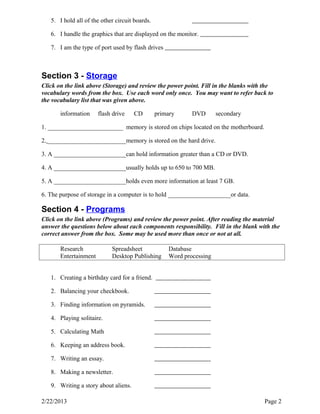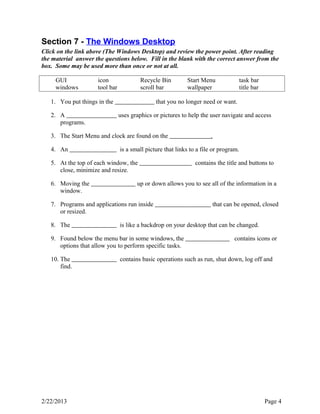Computer basics worksheet
- 1. Computer Basics Worksheet Directions: Complete this worksheet by filling in the blanks or as directed by your instructor. To learn about each section click on the section headings then answer the section questions. Pay close attention to the directions for each section. When finished study the answers CAREFULLY. Turn in the worksheet to your instructor unless directed otherwise. Start by reviewing the Computer Basic Overview. Click here for Vocabulary Section 1 - Input/Output Click on the link above (Input/Output) and review the power point about peripheral devices. As you read the information decide which of the following peripheral items INPUT information or OUTPUT information. Designate the type of peripheral component by writing INPUT or OUTPUT by each of the items below 1. Monitor 2. Keyboard 3. Scanner 4. Laser Printer 5. Mouse 6. Speakers 7. Digital Camera Section 2 – What’s Inside a Computer? Click on the link above (What’s Inside a Computer) and review the power point. After reading the material answer the questions below about each components responsibility. Fill in the blank with the correct answer from the box. Some may be used more than once or not at all. CPU BIOS power supply hard drive network card Motherboard RAM USB Port ROM video card 1. I connect computers and allow them to talk to each other. 2. I wake up the computer and remind it what to do. 3. I am the brain of the computer. 4. Information is stored on my magnetic cylinders. 2/22/2013 Page 1
- 2. 5. I hold all of the other circuit boards. 6. I handle the graphics that are displayed on the monitor. 7. I am the type of port used by flash drives Section 3 - Storage Click on the link above (Storage) and review the power point. Fill in the blanks with the vocabulary words from the box. Use each word only once. You may want to refer back to the vocabulary list that was given above. information flash drive CD primary DVD secondary 1. ________________________ memory is stored on chips located on the motherboard. 2. _________________________memory is stored on the hard drive. 3. A _______________________can hold information greater than a CD or DVD. 4. A _______________________usually holds up to 650 to 700 MB. 5. A _______________________holds even more information at least 7 GB. 6. The purpose of storage in a computer is to hold ____________________or data. Section 4 - Programs Click on the link above (Programs) and review the power point. After reading the material answer the questions below about each components responsibility. Fill in the blank with the correct answer from the box. Some may be used more than once or not at all. Research Spreadsheet Database Entertainment Desktop Publishing Word processing 1. Creating a birthday card for a friend. 2. Balancing your checkbook. 3. Finding information on pyramids. 4. Playing solitaire. 5. Calculating Math 6. Keeping an address book. 7. Writing an essay. 8. Making a newsletter. 9. Writing a story about aliens. 2/22/2013 Page 2
- 3. Section 5 - Programs Click on the link above (Vocabulary) and review the power point. After reading the material answer the questions below. Fill in the blank with the correct answer from the box. Some may be used more than once or not at all. downloaded translators installing programming program programmers 1. A is a set of instructions that tells the computer how to perform a specific task. 2. Programs are like that allow people to work with computers without learning the computer’s language. 3. Using bits and bytes in different combinations to represent a code is known as _____________________ 4. Copying a program onto your computer’s hard drive from another source is known as the program. 5. People who write codes to create programs are known as computer _____________________ 6. Some programs can be from the internet directly to your hard drive Section 6 - Operating Systems Click on the link above (Operating Systems) and review the power point. After reading the material answer the questions below. Fill in the blank with the correct answer from the box. Some may be used more than once or not at all. Windows operating system graphics upgraded user friendly 1. The large program that controls how the CPU communicates with other hardware components is the 2. A computer that is easy to operate is called 3. is the most common operating system for PCs. 4. Operating systems are constantly being as technology advances. 5. A Graphical User Interface (GUI) uses to help the user navigate within the computer system. 2/22/2013 Page 3
- 4. Section 7 - The Windows Desktop Click on the link above (The Windows Desktop) and review the power point. After reading the material answer the questions below. Fill in the blank with the correct answer from the box. Some may be used more than once or not at all. GUI icon Recycle Bin Start Menu task bar windows tool bar scroll bar wallpaper title bar 1. You put things in the that you no longer need or want. 2. A uses graphics or pictures to help the user navigate and access programs. 3. The Start Menu and clock are found on the . 4. An is a small picture that links to a file or program. 5. At the top of each window, the contains the title and buttons to close, minimize and resize. 6. Moving the up or down allows you to see all of the information in a window. 7. Programs and applications run inside that can be opened, closed or resized. 8. The is like a backdrop on your desktop that can be changed. 9. Found below the menu bar in some windows, the contains icons or options that allow you to perform specific tasks. 10. The contains basic operations such as run, shut down, log off and find. 2/22/2013 Page 4
- 5. Section 8 - System Requirements Directions: New software always has a minimum system requirement. Meaning that the computer CPU, RAM, etc. has to be of a certain quality to run that program. Look at the sample below, then, look at each specification listed to determine whether or not it will support the software. Check “yes” if the specification meets the system requirements, or check “no” if it does not. THE SOFTWARE’S MINIMUM SYSTEM REQUIREMENTS ARE: Windows 2000/XP 32 MB RAM or more Pentium 333 MHz or faster 16x CD-ROM drive or faster 56 MB available hard disk space THEN WILL THE FOLLOWING SYSTEMS WORK? 1. Yes No Windows XP, Pentium 333, 64 MB RAM, 150 MB free hard disk space, 24x CD-ROM. 2. Yes No Windows 98, Pentium 100, 8 MB RAM, 32 MB free hard disk space, 8x CD-ROM 3. Yes No Windows 2000, Pentium 333, 64MB RAM, 150 MB free hard disk space, 24x CD-ROM drive. 4. Yes No Windows XP, Pentium 4 (1.70 GHz), 256 MB RAM, 12 GB free hard disk space, 24x CD-ROM drive Section 9 - Hardware Basics Label the parts by finding the diagram in the presentation link above. 1)______________ 2) _____________ 3) _____________ 4) _____________ 5) _____________ 6) _____________ 7) _____________ 8) _____________ 9) _____________ 10) ____________ 11) ____________ 12) ____________ 13) ____________ 14) ____________ A 12 13 O| O| | B 11 10 O| O| | 1 8 6 2/22/2013 Page 5 2 3 4 5 7 9 14 Hard Drive Sound Power Supply CD/DVD CPU Motherboard BIOS RAM Video USB Network (NIC) Graphics Port Key Board Mouse
- 6. Section 10 - Organizing files and folders Click on the link above (The Windows Desktop) and review the power point. After reading the material answer the questions below. Under each Program Name and folder, write the appropriate file name and extension. Organizing Files rentals.xlsx brochure.pubmla.docxmaze.pptxgpa.xlsxfrance.pptxtabs.d oc xcalendar.pubcard.pubmemo.docx Excel PowerPoint Publisher Word 2/22/2013 Page 6
- 7. Section 11 – Parts of a Computer Fill in the blanks #1-#7 4 Main Parts of a Computer Part 1: This type of device is known as a(n)______________ devise. (Section 1) · It enables information to be passed into the computer. · It includes the: Keyboard, mouse, scanner, digital camera, microphone, etc. Part 2: This device is responsible for ___________________ (Section 3) · A unit that holds and gives information to the processor as needed. · There are two types of storage: 1. Temporary storage which holds information for short periods and only when the computer is on. i. Examples of temporary storage include RAM (R___________A__________ M______________ ) RAM allows stored data to be accessed in any order. (i.e., at random). 2. Long term storage holds information for as long as you want it. i. Examples of Long-term storage include Hard Disk Drive, CD-Rom, DVD, Flash Drive. Part 3: This is the brains of the computer. The _____________________________________ (Section 6) · It controls all functions. · The processor is called the CPU (C ___________ P___________ U__________) · The motherboard holds the CPU and physically connects all the other main parts of the computer. · Cases and chassis house the motherboard and the CPU. Part 4: This type of device is known as a(n)______________ devise. (Section 1) · A devise that receives information from the processor in the form of words, sounds or pictures. · These devises include printers, speakers and Monitor. 2/22/2013 Page 7
- 8. Section 12 – Fill in the blank areas with the correct answer 2. I______: A small picture that links to a file or program 4. W_____________: Programs and applications that can be opened, closed or resized 6. _________ Bar: Contains title and buttons to close, minimize and resize 8. __________ _____: Where you put things you no longer want 2/22/2013 Page 8 5. _______: Graphical User Interface Helps user navigate & access programs 10. __________ Bar: Includes the Start Menu and the Clock 9. _________ Menu: Contains basic operations such as run, shut down, log off and find 3. ________ Bar: Contains icons or options that allow you to perform specific tasks 7. _________ Bar: Allows you to see all of the information in a window 1. W__________: Backdrop (background) on the desktop







